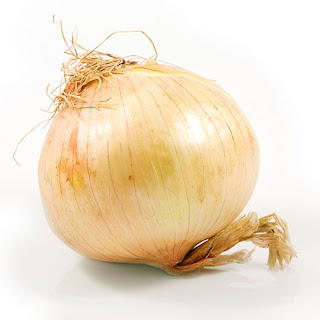Onion | Agriculture | Onion is the common name for the herbaceous, cold season plant Allium cepa, which is characterized by a edible, rounded bulb composed of concentric, fleshy, tightly packed, and enlarged leaf bases. Onion is also the name of this edible bulb, which is commercially valuable and known for its pungent oil that departs a strong taste.
Closely related plants of the same genus include chives (Allium schoenoprasum), garlic (A. sativum and A. scordoprasum), and leeks (A. porrum). There are other plants in the genus Allium that also have the common name of onion, such as the Welsh onion (A. fistulosum), but when used without qualifiers, onion usually refers to Allium cepa. It is also known as the garden onion.
Onions offer a unique (pungent) flavor and odor that makes them prized for a multitude of dishes. Furthermore, human creativity has improved upon the species by making a wide number of cultivars with different, desirable attributes.
The expression "layers of the onion" is used to describe a situation in which it is possible to go deeper and deeper revealing seemingly similar layers until a central core is reached. It has been used as a metaphor in mysticism to describe the supposed layers of reality.
Onions are variously placed in the flowering plant family Alliaceae or Liliales. Alliaceae, a family of herbaceous plants, are monocots and part of order Asparagales. The family has been widely but not universally recognized; in the past, the plants involved were often treated as belonging to the family Liliaceae, and still are by some botanists. The Liliaceae, or the lily family, is a family of monocots in the order Liliales. Plants in this family have linear leaves, mostly with parallel veins, and flower parts in threes. The lily family traditionally was a paraphyletic "catch-all" group that included a great number of genera that are now included in other families, such as those now placed in Alliaceae.
The onion, Allium cepa, is known only in cultivation; it is no longer found in the wild. However, related wild species occur in Central Asia. The most closely-related species include Allium vavilovii Popov & Vved. and Allium asarense R.M. Fritsch & Matin from Iran. However Zohary and Hopf (2000) warn that "there are doubts whether the vavilovii collections tested represent genuine wild material or only feral derivatives of the crop."
Allim cepa is believed to be of Asiatic origin. It is a hardy garden vegetable. The underground leaf bases, used in food storage, swell and form a tightly packed, concentric, fleshy bulb. As the bulb develops, the outer leaf base dries and becomes scaly, while the inner leaf bases thicken. The bulb is rich in carbohydrates and a sulfur-rich volatile oil. Onions are grown mainly for this edible bulb, which has a pungent odor and taste, but the above-ground leaves also are eaten.
Bolting (flowering) is initiated when temperates fall below 50° F. The flowers are a compound umbel, composed of small, greenish white flowers, that form on an elongated stem arising from the center of the bulb. The onion root system is fibrous and shallow, spreading from 12 to 18 inches below the soil. The onion is a perennial, but the cultivated forms often die after flowering in their second year (PFAF).
Numerous varieties of onions have been developed, with a diversity of flavors (mild or pungent), colors (white, yellow, brown, red), sizes, and shapes. Two main classifications are green onions (or spring onions, those harvested while immature) and dry onions (mature onions with a juicy flesh covered with dry, papery skin. Green onions are also known as scallions, which is a term associated with various members of the genus Allium that lack a fully-developed bulb. (The term scallion and green onion particularly is used to refer to the Welsh onion, Allium fistulosum, which is said not to produce dry bulbs.)
Together, garlics (Allium sativum), chives (A. schoenoprasum) and leek (A. porrum), scallions, are closely related to onions. Shallot, as the term is commonly used, actually refers to two different species of Allium plants. French gray shallots ratlines, which is considered "true shallot" by many, is Allium oschaninii, a species that grows wild in central Europe and southwest Asia. Other varieties of shallot are Allium cepa var. Aggregatum or multiplier onions, which are considered by some as a variety of onion, but others list separate species A. ascalonicum.
Tags: onion tv club, onion health benefits, onion router, onion cell lab, the onion router, onion routing, blazing onion, blind onion, personals onion, red onion gainesville, onion personals, the onion personals, homemade onion rings, onion pub barrington, onion remedies, onion breath, blind onion pizza, red onion nutrition, onion nutrition facts






Nice post!! We supply good quality of onion across the world. The products are grown under most natural conditions without the use of harmful herbicides.
ReplyDelete